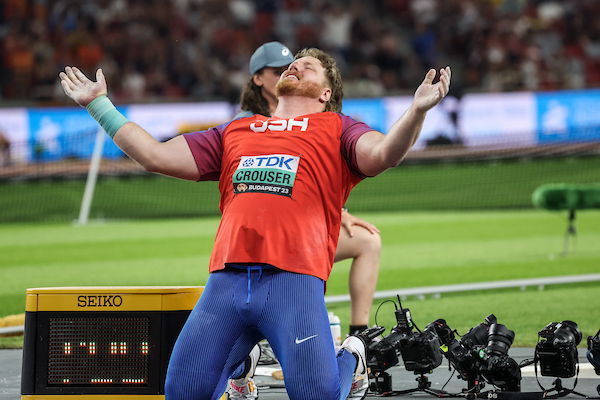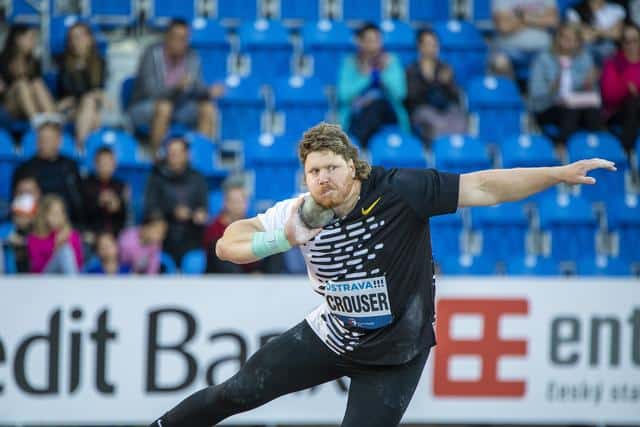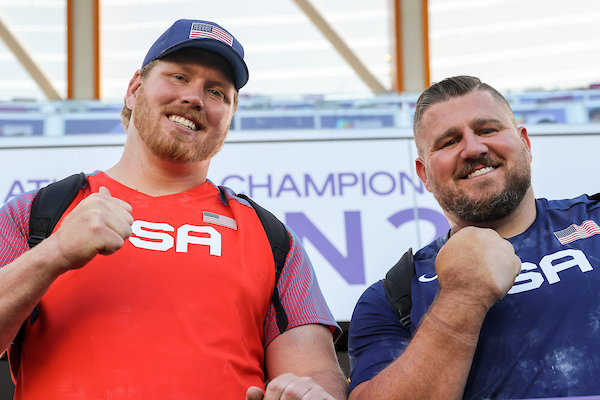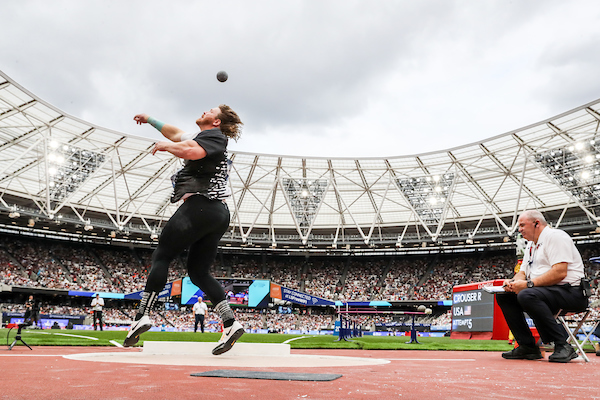Ryan Crouser – triple Olympic champion
What more is there to say about Ryan? Let’s start with his own depiction of his profession for someone who has never seen it: He came up with the analogy of finding the heaviest ten-pin bowling ball, standing on a basketball free-throw line, turning around and using one hand, shooting a basket at the far end!
Two personal stories about the man. I approached him at the final Diamond League of the season for an interview. “Sure. Give me a month, then contact my agent.” “Contact my agent” often means “No, but I will let my agent say No”. A month later, I asked again, and it was set up on Zoom. The Zoom link does not work, so it is an easy out – but no. Contacts agent who tells me. New Zoom link, and he is waiting. Great interview. What a gentleman, what integrity!
One year, in Lausanne, he was on media duties, speaking to a Swiss radio reporter who clearly knew nothing of shot put and asked inane lifestyle questions. Ryan answered every dumb question with grace. I was next up and asked if it was okay if I asked him about shot put—a polite smile.
So how do you put a shot 22 m? When Ryan is the man to ask – so I did.
1. Physical attributes required?
Ryan Crouser: “On the bigger side, as far as the build goes, it is good. If you are skinny and built like a distance runner with narrow shoulders and a lighter bone frame, it’s hard to throw the shot a long way. But I would say that’s not a make or break because, when I was younger, I was tall and skinny. It’s a misconception that it’s just about how much can you bench press. Being an all-round athlete and how you move is important; a good sense of rhythm is also important. So a really good athlete, on the bigger side because if you’re big and strong that helps. But I would say it’s easier to get bigger and stronger than to develop a natural athleticism.”

2. What generates distance – technique, speed, strength?
Ryan Crouser: “For me, at this stage, it’s a game of inches, trying to get it where I can. The technical gains are the largest in terms of gaining distance. Speed and strength, I would describe as limiting factors. If you are not strong enough to be proficient through the movements, that can be detrimental. And if you can’t go fast enough that can also be detrimental. “

3. Glide or rotate
Ryan Crouser: “From the 1960s the glide has been the dominant technique. You start with your back facing the toe board and make a single glide movement across, pushing off your right foot then right foot, left foot in the power position and throw the ball. That was for a long time the textbook prototypical method. In the 1970s a few athletes started applying a discus style rotational movement in the shot with varied success. For a while rotational throwers would throw well throughout the year but had trouble performing at major championships because there’s a lot more movement, about 180°and then as full 360 rotation. It’s a much more complex movement. It wasn’t until probably 2016 that the rotational has been dominant in major championships. And that is how shot put technique is mainly evaluated by what has happened at major championships. I would say that we’re in the golden age of rotation now. From the early 2000s, the rotational throwers would throw far but had trouble throwing far when it counted.
I have used both methods. I used the glide until I was 18 so I have a good understanding of, not my limits, but what the possibilities were because I threw with the glide and then switched to the spin. I spent seven or eight years throwing with the glide so I have a pretty good understanding of it. I thought that I could still have success with the glide but that the upward potential of the spin was greater.”

4. Is being tall an advantage or disadvantage?
Ryan Crouser: “It can be either one. The problem with being tall for the shot is that the ring is relatively small. I think it is 1 foot 2 inches shorter than the discus ring. That is probably why you see more of the taller athletes throwing the discus. Because the discus ring is larger it makes the movement easier, because you have a bigger area to work with. But in the shot its condensed down to 7 foot ring with that toe board at the front. Being tall from a physics perspective can be an advantage because you have longer levers and therefore longer time to apply force to the shot. The downside of being tall is that for me the circle is very small. Take Tomas Walsh or Joe Kovacs, they can be really dynamic across the ring. I can’t have a sprint dynamic technique. I have to have a technique which is very conservative, which is focused on how do I keep my 6 foot 7 self from fouling at the front of the circle.”

London Athletics Meet
July 23, 2023, London, England, U.K., photo by Kevin Morris
Author

Since 2015, Stuart Weir has written for RunBlogRun. He attends about 20 events a year including all most global championships and Diamond Leagues. He enjoys finding the quirky and obscure story.
View all posts






















